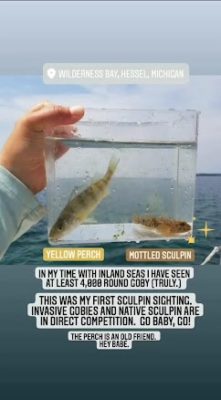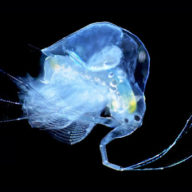Working and teaching aboard a traditionally rigged tall ship have its perks. My office has incredible views from all angles and the students are never bored. What is particularly rewarding about teaching on our tall ship, Inland Seas, is that I have cultivated an intimate relationship with the patterns of Grand Traverse Bay. Because we offer science programming daily in the spring and fall, I get to see firsthand how the changing seasons play out in the water. After four-sailing seasons I know that plankton samples begin to diversify in early June when the chill of winter finally loosens its grip on the water column. The reproduction patterns of invasive round goby pile up in early August and we start catching insane numbers of this fish. There are organisms that we see in every season; I have begun calling them “frequent fliers.” All of this knowledge helps me to tell a story that our learners understand. As we traveled around Lake Huron, the Detroit River, and Lake Superior this summer, I was literally in uncharted waters, in terms of my own ecological familiarity, and could not lean into my expertise of local trends to tell our Great Lakes story. Lucky for me, I have spent the better part of the last ten years building a personal encyclopedia of Great Lakes information so I wasn’t flying blind by any means. However, there is a difference between reading about a water body and experiencing it for yourself. Each port left me with the very best gift: more questions.
Lake Huron
 In my time with ISEA, our first stop outside of Lake Michigan has always been Wilderness Bay near Hessel, MI. The chemistry of this water is similar to that of Grand Traverse Bay: a healthy pH and a good amount of oxygen, but the diversity of organisms tends to be greater. In this area, we do catch round goby, a frequent flier, but we also collect their native competitor, mottled sculpin! These fish are in direct competition with one another and having them both on board is an exciting opportunity to show students how to tell them apart. The community of organisms living on the bottom of Wilderness Bay is also quite exciting. The burrowing mayfly, one of my personal favorites, has been found nearly every year. These species have tusks on the front of their head that allow them to dig into the sediment at the bottom. Their gills are long and feather-like flowing over their abdomen. This family of mayfly is incredibly sensitive to pollution so their presence tells us that the water and sediment here are in peak condition.
In my time with ISEA, our first stop outside of Lake Michigan has always been Wilderness Bay near Hessel, MI. The chemistry of this water is similar to that of Grand Traverse Bay: a healthy pH and a good amount of oxygen, but the diversity of organisms tends to be greater. In this area, we do catch round goby, a frequent flier, but we also collect their native competitor, mottled sculpin! These fish are in direct competition with one another and having them both on board is an exciting opportunity to show students how to tell them apart. The community of organisms living on the bottom of Wilderness Bay is also quite exciting. The burrowing mayfly, one of my personal favorites, has been found nearly every year. These species have tusks on the front of their head that allow them to dig into the sediment at the bottom. Their gills are long and feather-like flowing over their abdomen. This family of mayfly is incredibly sensitive to pollution so their presence tells us that the water and sediment here are in peak condition.
Wilderness Bay always gets me thinking. Lake Michigan and Lake Huron are connected water bodies at the same elevation. Technically, they are one lake. What factors here have such a positive impact on biodiversity? Can any of those factors be brought home to Grand Traverse Bay?
Detroit River
 Detroit is becoming one of my very favorite ports. Our ship is warmly received by the community and we have incredible conversations with passersby on the public riverwalk. It is also the only port where I can Doordash smoothies directly to the ship. I love city living. Anyway, when it comes to our programming on the Detroit River we are actually rather limited in our sampling capacity. The river is an international Area of Concern (AOC.) Areas of Concern are water bodies under scrupulous management by regulatory committees to mend environmental damage. Decades of untreated industrial waste discharge, stormwater runoff, and urban development have left the river in poor environmental condition. Because of these factors, we do not trawl for fish or collect benthos samples within the river to avoid disturbing the restoration efforts. We set fish traps off of the docking area with high hopes, but the river’s strong current and depth prevented any fish from swimming into the trap. (Aside: We did catch a single yellow-perch in the plankton net, a one-in-a-million catch! It was eager to leave the ship, however, and made a heroic leap out of containment at the first available opportunity.) This left plankton as our sole biological sample. I am always surprised at the diversity and abundance of plankton we find within the flow of the Detroit River. Colonial rotifers were so abundant this year and their movement is wild to see under the scope! Asplancna, rotifers, and copepods all showed up to dance across our monitor.
Detroit is becoming one of my very favorite ports. Our ship is warmly received by the community and we have incredible conversations with passersby on the public riverwalk. It is also the only port where I can Doordash smoothies directly to the ship. I love city living. Anyway, when it comes to our programming on the Detroit River we are actually rather limited in our sampling capacity. The river is an international Area of Concern (AOC.) Areas of Concern are water bodies under scrupulous management by regulatory committees to mend environmental damage. Decades of untreated industrial waste discharge, stormwater runoff, and urban development have left the river in poor environmental condition. Because of these factors, we do not trawl for fish or collect benthos samples within the river to avoid disturbing the restoration efforts. We set fish traps off of the docking area with high hopes, but the river’s strong current and depth prevented any fish from swimming into the trap. (Aside: We did catch a single yellow-perch in the plankton net, a one-in-a-million catch! It was eager to leave the ship, however, and made a heroic leap out of containment at the first available opportunity.) This left plankton as our sole biological sample. I am always surprised at the diversity and abundance of plankton we find within the flow of the Detroit River. Colonial rotifers were so abundant this year and their movement is wild to see under the scope! Asplancna, rotifers, and copepods all showed up to dance across our monitor.
Before Detroit, I had never sampled plankton in a river system. I wonder if there is something about the current that helps them thrive and diversify. The river’s status as an AOC does not seem to have severely impacted the plankton community. How might it continue to change as the river’s quality improves?
Lake Superior

We spent two beautiful weeks in the young waters of Lake Superior. As a matter of fact, aside from being famously large, Lake Superior is one of the youngest major features on the Earth’s surface. It’s only been about 4,000 years since the Laurentide Ice Sheet retreated from her water. This was reflected most in the plankton community. The schooner Inland Seas visited three separate ports along the coast of the Upper Peninsula and at each we found only two to three species of zooplankton. There was an abundance of holopedium, though they look different from the ones we see at home. We also encountered a kind of rotifer that none of us recognized, which was exciting! This less diverse population is not necessarily a sign of poor health. To tiny organisms like plankton the temperature of water is critical to success. In other lakes, plankton communities have had a couple additional thousand years to evolve and grow without ice water melting into their basins. As an added boost to the community, the bedrock of Lake Superior is not conducive to the growth of quagga mussels. Quaggas are an invasive that filter plankton out of the water; their absence means that this community should continue to diversify in the coming years!
How do new plankton integrate into the food web? They are so incredibly small, does it happen faster than other organisms?
I have never been under the impression that I knew everything about the Great Lakes. That would be ludicrous. This summer tour aboard our science schooner has done wonders to show me the magnitude of things I do not know about the Great Lakes.The ecosystem is huge and ever-changing, making it impossible to know everything. Seeing these new-to-me pockets of the lakes certainly offered a better understanding of how our local frequent fliers factor into the whole system. For instance, everywhere we went, we saw bloodworms, the most dependable organism in Grand Traverse Bay. I am overjoyed to have this new perspective while I am introducing students to our water during Fall Schoolship. Grand Traverse Bay is not new to me but I am coming home with new eyes and full of fresh questions.
What does it look like when a crayfish eats? How old are Petoskey stones, exactly? Are there other factors that led to a decrease in mottled sculpin? Why is our benthic plant and algae community mostly one native species (chara)? What is the annual accumulated runoff of Traverse City? How do the plastic accumulations compare to other coasts? Who can we talk to about fishhook water fleas?
This blog was written by Rachel Ratliff, an educator for Inland Seas Education Association. Rachel obtained her degree in natural resource management with a minor in biology from Grand Valley State University. She first began her journey with ISEA as an education intern in the summer of 2018 and has a passion for experiential education as well as public outreach and communication.